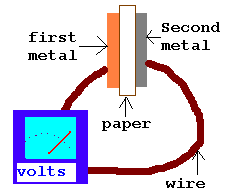Ohm's Law
Lesson Plan - Discovering Ohm's LawUsing a computer model of a circuit board the students will explore the relationship of resistance, voltage and current in series and parallel circuits. They will discover Ohm's Law by constructing series circuits with one resistor and putting the resultant resistance, current and voltage into a worksheet. Next they need to discover how to apply their law to series circuits with multiple resistors and or batteries. Finally they propose a plan for applying their understanding of ohms law to parallel circuits they construct. Goals and ObjectivesThis lesson addresses these National Science Education Standards: 5-8 grade: Electrical circuits provide a means of transferring electrical energy when heat, light, sound, and chemical changes are produced. Students in grades 5-8 can begin to differentiate between science and technology, although the distinction is not easy to make early in this level. One basis for understanding the similarities, differences, and relationships between science and technology should be experiences with design and problem solving in which students can further develop some of the abilities introduced in grades K-4. The understanding of technology can be developed by tasks in which students have to design something and also by studying technological products and systems
Student PrerequisitesStudents need to be familiar with the use of a computer mouse. They need to be able to add, subtract, multiply and divide.
Suggested introductory activity, Making BatteriesMaterials needed:
First, have the students practice using their voltmeter with a flashlight battery. Be sure that they know what to expect when electricity is flowing through the meter.
Select two different kinds of metals. Separate them with the paper towel soaked in saltwater. Both of the metals must touch the paper. Don't let the metals touch each other. This is their battery. Connect the voltmeter the same way they did with the battery. Record the voltage of their battery. Repeat the process with different metals. Throughout this lesson the student questions are RED The suggested answers are BLUE Ask the students: Which pairs of metals make the strongest and weakest battery? (Answers will vary depending on the metals used. If the battery consisted of 2 examples of the same metal i.e. steel chair and steel scissors the voltage will be approximately 0) Were any of your batteries as strong as the flashlight battery? (Answers will vary.) When the students drop a battery or meter on the circuit board a dialog box will appear. All components have some internal resistance. By assuming an ideal condition with no internal resistance our calculation are greatly simplified. Be sure to remind the students to test their circuits using this ideal condition. After they have found Ohm's Law they can go back and check the real world condition by replacing the internal resistance in their circuit board and their calculations. Answers to questions found throughout the lesson.
Change the light bulb values by right clicking or control clicking the light bulb. Experiment with different values. Answers will vary depending on the voltage of their battery. A 3 volt battery, with a 3 watt, 3 volt bulb is bright. Change the value of the resistance and or battery's voltage in your circuit. Put the circuit's values into the second row on the worksheet. If the student has the correct operations they will work for each row. Voltage = resistance X current resistance = voltage / current Current
= voltage / resistance Answers will vary. Scientist have checked this relationship many times and found that metals follow this rule at normal temperatures. Nonohmic materials and even metals at exotic temperatures don't follow Ohm's law. The usefulness of most modern electronic devices and even light bulbs comes from how they violate Ohm's law. Build several circuits with 2 resistors and one battery in series. Put the values into the worksheet "Ohm's Law with 2 resistors in series". Replace the ? between voltage and current with the operation you discovered in the first worksheet. Replace the ? between the resistors with + - / or X to make the statement true.
Ohm's Law ResourcesThese are additional background materials and links to resources that may help you prepare for and extend the lesson. http://jersey.uoregon.edu/vlab/Voltage/has an interactive circuit with interchangeable batteries and resistors. The students goal is to pick the correct battery/resistor combination to light up the bulb without burning it our. http://www.grc.nasa.gov/WWW/K-12/Sample_Projects/Ohms_Law/ohmslaw.html has a short quiz on Ohm's law. http://hyperphysics.phy-astr.gsu.edu/hbase/electric/watcir2.html#c2 A discussion with diagrams of the analogy of water pressure to voltage in simple circuits. http://www-gap.dcs.st-and.ac.uk/~history/Mathematicians/Ohm.html A biography of George Simon Ohm. |




